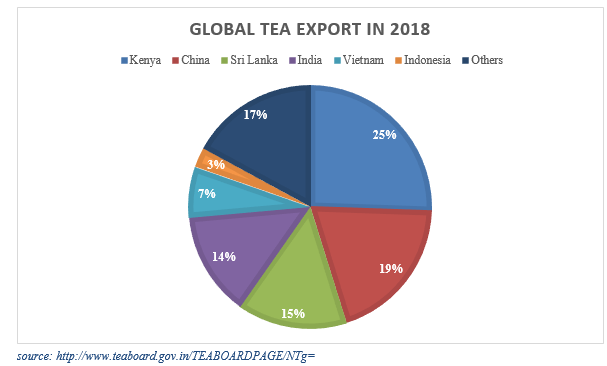INTRODUCTION
Tea is one of the ancient and non-alcoholic beverages made
steeping the leaves of Camellia Sinensis used throughout the world because of
its taste, aroma and health benefits. There are different types of tea across
the globe like Black tea, Green Tea, Yellow, Oolong and White tea etc., in
which black tea is more than 75% of all tea produced in the world and 20% is green tea.
Tea has many antioxidants like polyphenols (theaflavins,
thearubigins and catechins) that can help prevent several chronic diseases
including cancer. There are a wide range of tea available in the market across
the globe, but some of black tea hail from the Indian regions like Assam,
Darjeeling and Kangra. There are numerous scientific evidence showing that
black tea can make significant contribution to a healthy lifestyle, and in the
area of chronic diseases including cardiovascular health and dental hygiene.
Production Highlights
India is the 2nd largest producer of tea in the
world after China, including the famous Assam tea and Darjeeling tea. In 2018,
Global tea production was 5896.65 M Kgs (Million Kilograms) in which India’s
share was 22.70 % (approx. 1338.63 M Kgs).
In India, Assam is leading tea producing state followed by
West Bengal, Tamil Nadu, Kerala, Tripura, Arunachal Pradesh and Himachal
Pradesh.
Among the ASEAN countries, Vietnam and Indonesia are major
tea producing countries with Malaysia and Myanmar contributing very small to
the production. In total global tea production Indonesia (131 M Kgs) &
Vietnam (163 M Kgs) are ranked 5th and 6th respectively. Indonesia
contributes only 3% share of the global tea market.
Generally, cost of production and rising prices has led
tea farmers to switch to higher production of crops such as rubber, palm oil
and vegetables. In recent years, tea production in Indonesia has decreased from
146.68 M Kgs in 2014 to 139.36 M Kgs in 2018.
Major Tea Exporters
Major Tea Exporters
India is the 4th largest exporter of tea led by Kenya,
China & Sri Lanka. In 2018, total global tea export was 1858.82 M Kgs in
which India’s share was 13.77% (256.6.06 M Kgs).
In ASEAN countries, Vietnam and Indonesia are major
exporter of tea, globally ranked 5th & 6th respectively. ASEAN countries
except Vietnam & Indonesia do not produce tea and they mostly import it
from neighboring countries. That is why India has great opportunities to expand
their tea exports in ASEAN countries.
Drivers for Increasing Demand
Drivers for Increasing Demand
All the ASEAN countries (Malaysia, Myanmar, the
Philippines, Singapore, Thailand, and Vietnam etc.) are tea-drinking nations,
but except few, the other countries do not produce the beverage and hence there
is enormous potential of exporting tea to these countries.
In Singapore and neighboring countries, people consider tea
as a healthier option to coffee. Singapore’s consumer market is driven by young
people which has a great interest in specialty teas, regardless of the health
benefits of drinking it. Singapore and nearby nations are adopting a global industry
trend that combines tea into other aspects of daily lifestyle such as cocktails
or cuisines. Many eateries in these countries are already cooking with tea and
cafes or restaurants have modified their menus to serve to tea lovers.
Black tea consumption in ASEAN countries is expected to
grow by 2% according to the world report on the tea outlook for 2027. Vietnam
is ranked 7th & Indonesia is ranked 13th in a slot of global
import of tea. So, there is an immense opportunity for India to target ASEAN markets.
REFERENCES
Ø https://www.aseanbriefing.com/news/investing-aseans-tea-industry/



Useful information...thank you Miss Neha Sharma
ReplyDeleteKeep it up
Good one ma'am
ReplyDeleteGood work keep it up 👍👍
ReplyDeleteGood work!
ReplyDeleteThis comment has been removed by the author.
ReplyDeleteKeep it up!
ReplyDelete